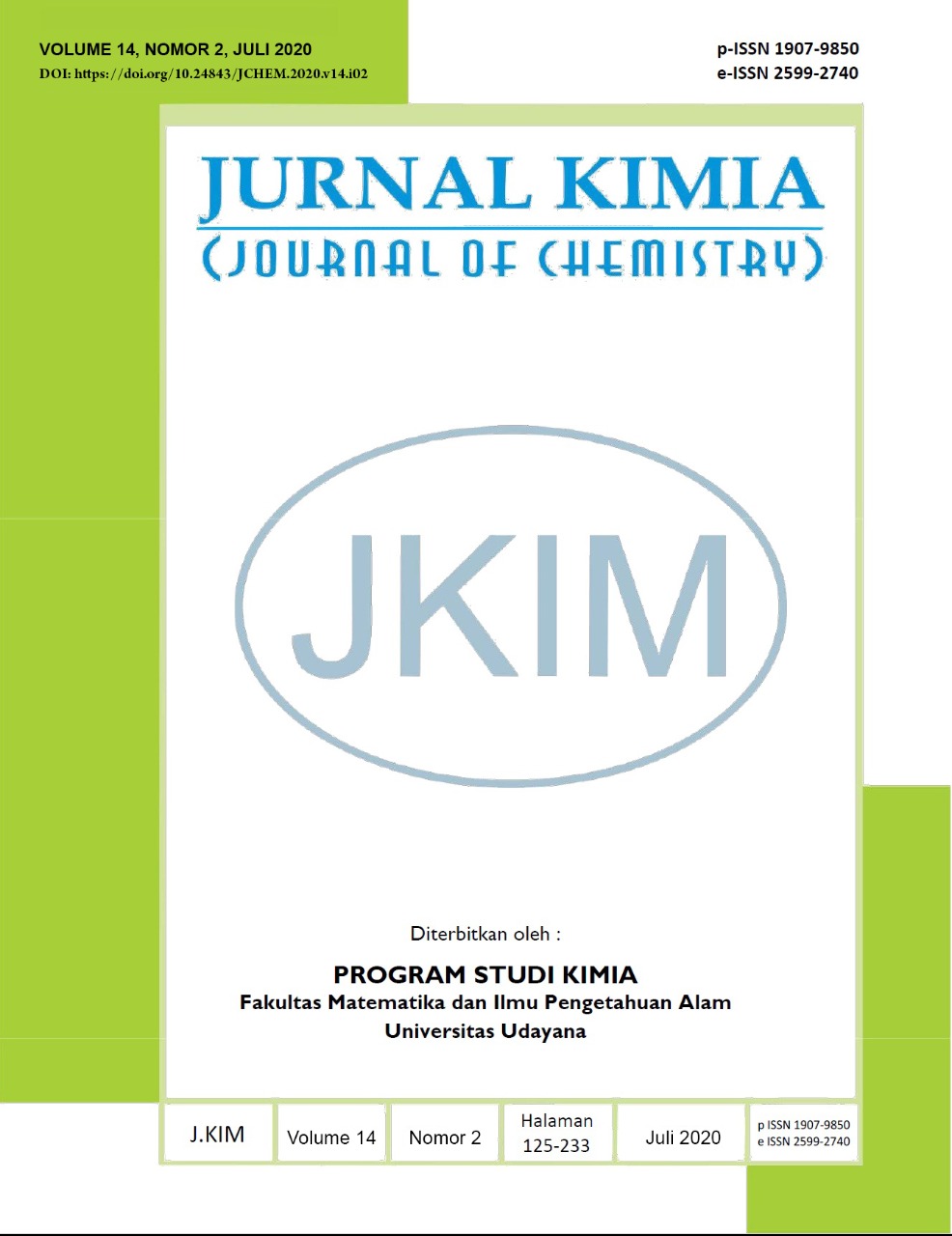ANALISIS SENYAWA TERPENOID ANTIJAMUR PADA FRAKSI AKTIF EKSTRAK KULIT KAYU CEMPAKA PUTIH (MICHELIA ALBA) DENGAN METODE GAS CHROMATOGRAPHY-MASS SPECTROSCOPY
Abstract
Ekstrak kulit kayu cempaka putih (Michelia alba) mampu menghambat pertumbuhan jamur Curvularia verruculosa yang diisolasi dari daun padi yang terserang penyakit bercak daun. Pemisahan senyawa aktif telah dilakukan dengan metode kromatografi kolom menggunakan fase diam: silica gel dan fase gerak: campuran n-heksana-aseton (3:1). Hasil pemisahan diperoleh 10 fraksi gabungan, dimana 4 fraksi menunjukkan daya hambat yang sangat kuat, yaitu fraksi HAE (31,50 mm), HAF (30,13), HAG (48,50), dan HAH (34,88).Komposisi senyawa terpenoid pada keempat fraksi ini dianalisis dengan GC-MS. Senyawa ledenoxid-(II) dan isoaromadendrene epoxide ditemukan hampir pada semua fraksi aktif, sedangkan spathulenol ditemukan pada fraksi HAF dan HAG. Senyawa terpenoid lainnya yang juga ditemukan adalah cis-farnesol, trans-p-mentha-1(7),8-dien-2-ol, dan neoclovenoxid-alkohol hanya pada fraksi HAE, (-)-caryophyllene oxide dan tomentosin hanya pada fraksi HAG. Seluruh senyawa terpenoid yang terdeteksi merupakan senyawa dari kelompok seskuiterpen.
Kata Kunci: Ekstrak, daya hambat, Currvularia verruculossa, seskuiterpen
Downloads
References
Cohen, Y., Wang, W., Ben-Daniel, B.H., and Ben-Daniel, Y. 2006. Extracts of Inula viscosa Control Downy Mildew of Grapes Caused by Plasmopora viticola. The American Phytopathological Society. 96(4):417-424.
Grayer, R.J. and Harborne, J.B. 1994. A Survey of Antifungal Compounds from Higher Plants, 1982-1993. Phytochemistry, 37(1): 19-42.
Hogan, D. A., Vik, A., and Kolter, R. 2004. A Pseudomonas aeruginosa quorum-sensing molecule influences Candida albicans morphology. Mol. Microbiol. 54: 1212–1223.
Kagale S, Marimuthu T, Thayumanavan B, Nandakumar R, Samiyappan R. 2005. Antimicrobial activity and induction of systemic resistance in rice by leaf extract of Datura metel against Rhizoctonia solani and Xanthomonas pv oryzae. Physiological and Mole. Plant Pathol. 65: 91-100.
Kuc, J. 1995. Phytoalexins, Stress Metabolism, and Disease Resistance in Plants. Annu. Rev. Phytopathol, 33: 275-297.
Omezzine, F., Daami-Remadi, M., Rinez, A., Ladhari, A., and Haouala, R. 2011. In vitro assessment of Inula spp. organic extracts for their antifungal activity against some pathogenic and antagonistic fungi. African Journal of Microbiology Research Vol. 5(21),: 3527-3531.
Rout, S., and Tewari, S.N. 2012. Fungitoxic Spectrum of Amalaba Against Fungal Pathogens in Rice Under In Vitro. J. Biopest. 5:161-167.
Spring, O., Albert, K., Hager, A. 1982. Three Biologically Active Heliangolides from Helianthus annuus. Phytochemistry. 21(10): 2551-2553.
Takasugi, M., Okinaka, S., Katsui, N., Masamune, E., Shirata, A., Ohuchi, M.J. 1985. Isolation and Structure of Lettcinin A, A Novel Guaianolide Phytoalexin from Lactuca sativa var. capitata (Compositae). J. Chem. Soc. Chem. Commun. 621-622.
West, J.S., Bravo, C., Oberit, R., Lemaire, D., Moshou, D., McCartney, H.A. 2003. The Potential of Optical Canopy Measurement for Targeted Control of Field Crop Diseases. Annual Review of Phytopathology, 41: 593–614.
Yoon, M.Y., Cha, B., Kim, Jin-Cheol. 2013. Recent Trends in Studies on Botanical Fungicides in Agriculture, Plant Pathol J., 29: 1–9.
Yang, D., Michel, L., Chaumont, J.P and Millet-Clerc, J. 1999. Use ofcaryophyllene oxide as an antifungal agent in an in vitroexperimental model of onychomycosis. Mycopathologia, 148: 79–82,
Zhang, Y.Q., Cai, C., Yang, Y.X., and Weng, L. 2011. Blocking of Candida albicans biofilm formation bycis-2-dodecenoic acid and trans-2-dodecenoic acid. J. Med. Microbiol., 60: 1643–1650
Wang, L. H., He, Y., Gao, Y., Wu, J. E., Dong, Y. H., He, C., Wang, S. X., Weng, L. X., and Xu, J. L. 2004. A bacterial cell–cell communication signal with cross-kingdom structural analogues. Mol. Microbiol. 51: 903–912.

This work is licensed under a Creative Commons Attribution 4.0 International License






